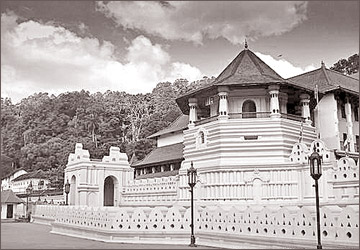Sri Dalada Maligawa Buddhist cultural heritage
Terrorists attacked on January 25, 1998:
Dr Daya Hewapathirane
Ambarawa is at the entrance to the Maligawa in the form of a tunnel
the entire curved surface was vibrantly adorned with colourful
paintings. It destroyed the enchanting Sandakada Pahana (moonstone)
built in keeping with the unique Mahanuwara tradition, at the entrance
to the Ambarawa and damaged the granite rock pillars which were adorned
with delicate and exquisite rock carvings of intricate traditional
motifs. Passing the Ambarava one enters the Hevisi Mandapaya (the open
verandah-like area) with pillars where ‘poojas’ (offering) and drumming
are performed.
|

Sri Dalada Maligawa. File photo |
Besides the damages to the priceless cultural wealth that was
associated with the Ambarawa, the blast resulted in the total
destruction of one of the most precious items of the Maligawa - the
historic moonstone that was found at the main entrance to the Maligawa.
It was one of the few most enchanting moonstones bearing the design and
shape of Mahanuwara moonstone tradition, somewhat similar to the one at
the entrance to the Degaldoruwa Vihara.
The destroyed moonstones, other rock structures have been replaced
with new ones bearing the same shape and design and the
Ambarawapaintings have been re-drawn. Many ancient ola palm leaf
manuscripts and delicate traditional ornaments and artifacts stored in
the Pattirippuwa octagonal building were destroyed. However, can they
ever replace these invaluable historic treasures that glorified and
embellished this cultural paradise of a place?
Except for some structural damages to the plasters and walls and
dislodging of parts of the carved wooden ceiling structures, most
miraculously the ancient inner relic chamber structure at the centre of
the Maligawa building where the Sacred Tooth Relic was housed remained
intact.
When conservationists sifted through the rubble after the terrorist
attack, they made an unexpected discovery. Beneath the existing wall
paintings, two earlier layers of plaster with paintings were detected.
Images of an elephant and a dancers leg were revealed which appears to
be a part of a wider artistic composition of a ceremonial pageant. This
painting is attributed to the beginning of the 18th Century, to the
period of King Narendrasinha. Fragments of these paintings are displayed
today in the new Maligawa museum, along with pictures of the destruction
wreaked by the terrorist attack.
Exceptional paintings of Maligawa
The earliest paintings of the period of the Mahanuvara Kingdom are in
the inner chambers of the Dalada Maligawa. They were completed during
the reign of King Wimaladarmasuriya-II (1687-1707). Other paintings in
the old Maligawa building were done during King Kirthisri Rajasinghe
(1747-1786).
Passing the tunnel-like Ambarava at the entrance to the main Maligawa
building, one enters the hevisi mandapaya or the open verandah-like area
with pillars where ‘Poojas’ and drumming are performed. In front of the
hevisi mandapaya is the two storeyed building where the Tooth Relic of
the Buddha is enshrined. This was built by King Narendrasinghe who ruled
from 1707-1739. The intricately carved wooden structures decorating the
upper portion of the outer walls of the two storeys also contain
exceptionally captivating paintings. Some of these paintings were done
on plaster applied over wooden surfaces.
On the walls and ceilings of both floors of this building are
paintings, which are exquisite. The wooden structures of the upper
portions of the outer walls of the two storeys are decorated with
intricate carvings. Paintings found in these structures are
exceptionally captivating. Some of these paintings were done on plaster
applied over wooden surfaces.
Most of the Maligawa paintings are elaborate thematic or decorative
ones. Those decorating the walls and ceiling of the inner relic chamber
are most breathtaking. There are paintings of beautiful designs using
human figures, animals, birds and flowers. Some are found on the carved
wooden ceiling structures associated with the Relic Chamber. Among some
especially appealing paintings found here are those depicting King
Wimaladarmasuriya-I (1591-1604), King Kirthisri Rajasinghe, Weliwita
Saranankara thera, jataka tales and the Esala Perahera. Paintings of the
Suvisi Vivarana or the 24 former Buddhas, deities and heavenly beings
are gorgeous. A particularly striking painting in one of the Shrine
rooms with a Buddha image is a stunning Makara Thorana which is a great
work of art.
Modern paintings of Upasena Gunawardene are in the new Maligawa
Annex. They narrate the story of the Tooth Relic and its enshrinement in
the Maligawa. The Dalada Maligawa museum established in recent years on
the upper floor of the Maligawa Annex contains segments of the painting
layers damaged by the bomb blast and photographs of some of the damaged
original paintings and parts of the paintings of several inner wall
surfaces that were exposed after as a result of the bomb blast and
peeling off of walls. Canvas replicas of some Maligawa paintings adorn
the stairways leading to the Museum.
Greatest of national treasures
The Dalada Maligawa originally built in the late 15th Century is more
than 550 years old and was added to, expanded and improved by several
kings in the centuries that followed. This fabulous structure enshrines
the sacred Tooth Relic of the Buddha venerated by Buddhists all over the
world. It is of utmost symbolic value for Buddhists and the nation as a
whole, because from historic times the possession and custodianship of
the Sacred Tooth Relic was tantamount to acquisition of the sovereignty
of the nation. Besides, the Dalada Maligawa is also famous
internationally for it colourful 10 day procession called the Dalada
Perahera, which has an unbroken tradition extending up to the fourth
Century CE.
This captivating and delightful pageant has been conducted for the
past 1700 years in several historic capitals in the country, when it was
customary for our kings to built special Dalada Maligawa structures in
those capitals to enshrine the Tooth Relic. Sri Dalada Maligawa is one
of the greatest national cultural treasures of our country and it should
receive the highest level of protection. |



